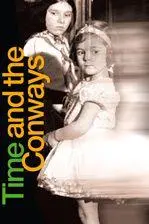Human cloning has long been a reality. For evidence of this remarkable achievement; scientists need look no further than the National Theatre where there are only two people in the entire audience for J.B. Priestley’s Time And The Conways. One of them has white hair and is wearing that indefinable shade of colourless beige so beloved of that generation who do not know what year it is but vividly remember Priestley being born. The other is a complacent, puffy-faced public school type with a loud, drawling voice who languidly lolls in the Lyttleton; making steeples from long, inbred, piano lessons fingers. It is hard to say which is more annoying: the staggering oldies who take a geological age to get to grips with the fiendishly complex alpha-numeric seating system or the young Camerons who bray out gems like this: “It’s just words and no drama, that was the trouble with a hundred years ago; everything was soooo overwritten. Come on JB tweet us the point.”
I had the misfortune to be stuck next to a batch of type two clones. It looked like I was in for a pretty miserable evening until I realized that this 21st century Smugness of Thick Hairs – trying out a new collective noun here – had a great deal in common with the young Conways in Priestley’s play. Time And The Conways is a three-act story about the same middle-class family in 1919, 1938 and back to 1919. The Conways brim and bloom with post Great War optimism but, by the time World War II is becoming inevitable, bitterness and decline have overtaken all and some live to rue their former folly. The play’s final act shows the sowing of the seeds of the family’s future doom in the very height of their pomp.
‘Things don’t always go according to plan’ and ‘Young people are annoying know-alls’ are not exactly revelations and not really what this play is concerned with. Priestley sought to elucidate Dunne’s theory of time in Conways. Dunne postulates that time might be circular or spherical rather than linear: our experience of the present may only be a glimpse of a fragment of an ever present whole. Comfort can be derived from the thought that one’s younger, stronger self still has material being and is just as real as the current incarnation. The self-contained universe of a play is a good example of what Dunne was talking about: the story and characters exist in their entirety before, during and after any given performance. So alas do the young Camerons in the audience.
Director Rupert Goold is wise enough to allow his strong cast to deal with the domestic drama at the heart of the piece while some very clever special effects do Dunne’s ideas ample justice. It is essential that the audience care about the characters or the second act falls flat and the third rings hollow. Emotional engagement is easily achieved by strong performances throughout. It is no easy feat to play the same character with a 19 year age gap; even the magic of cinema does not always allow an actor to pull it off. Francesca Annis makes it look easy as manipulative matriarch Mrs Conway and her high standards are more than matched by Hattie Morahan as the lead, Kay Conway, and Fenella Woolgar’s subtle, understated performance as shy eldest son Alan.
Loath as I am to credit the Smugness with any insight, there’s no denying that Priestley’s prose style feels out of fashion in 2009: David Mamet it ain’t but, even if Dunne is discredited, Time And The Conways will stay with you once you’ve seen it.





